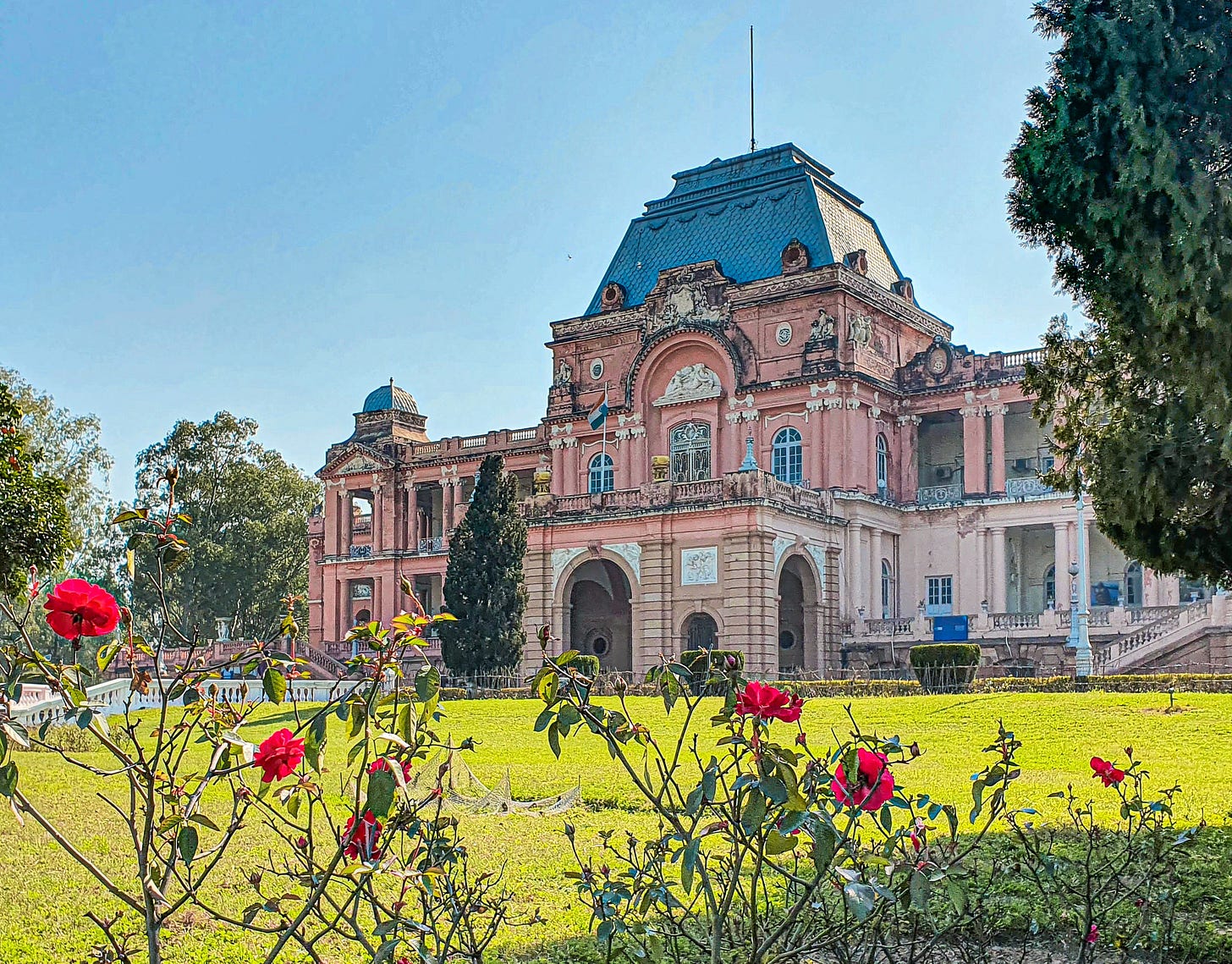The Versailles of Punjab
(The Story of the Only Pomeranian Dogs to Have Ever Dived off the Qutb Minar)
Late last summer, my friends and I set out for the Nicholson cemetery in search of a very specific person: Princess Eugene Grosup of Kapurthala, also known as Tara Devi.
The reason for our search was a small column I'd found in the Lahore Gazette whilst researching Partition. On 8 December 1946, as communal riots spreading across India, she and her two Pomeranian dogs had fallen to her death from the top of the Qutb Minar in Delhi. Some said it was suicide. Some said it was murder.
The more I researched, the more fascinating her story became. Indeed, I think its one of the craziest stories I’ve ever had the pleasure of writing about!
The Francophile Prince of Punjab
Our story begins in 1920s Kapurthala, a large princely state in Punjab which was ruled over by the prolific travel writer, Francophile and art connoisseur called Jagatjit Singh.
A scion of the Ahluwallia dynasty, Jagatjit Singh had first left Punjab at the age of twenty, embarking on a world tour. He hated London, loved Florence, and grew convinced that Native American languages were related to Turkic ones.
"I was surprised," he wrote in the USA, " to find several words in their language that have a strong resemblance to Turki as spoken in Central Asia. I am inclined to think they are of Mongolian origin, having crossed over into American by way of Kamchatka"
Of all the places he visited, however, it was Paris that really stole his heart. The Belle Èpoque was in full flow, and the city was awash with new ideas.
Inspired by what he saw in Paris, over the coming years Jagatjit Singh transformed his Punjabi Kingdom into the artistic epicentre of Northern India. He arranged for a replica of Versailles to be built in his capital and in letter to the Paris based architectural firm Macel e Boyer, he wrote "You know how devoted I am to French Art in all its forms. To me, French art stands for delicacy, elegance and above all for harmony... I was anxious to build in my capital a palace of European style."
Interiors were covered in Damask fabrics and zebra drawn carriages ferried guests around the gardens. One visitor, Rosita Forbes, described it as: "A scrap of Paris laid at the foot of the Himalayas... a feudal village admirably maintained... Prison or palace, law court or post office... [all] have the same charming appearance of being planned for an exhibition of decorative art."
Once complete, Jagatjit dedicated the palace to his fifth wife, a flamenco dancer from Spain called Anita Delgado. Anita subsequently lived alongside Jagatjit's four other wives in the zenana, and remained there until the two separated in 1925, perhaps due to the stream of European lovers who began to frequent the palace, including silent film actress Jane Renouardt.
Over time, Jagatjit grew into a veteran politician in his own right, attending the Paris Peace Conference, and representing India three times at the League of Nations between 1926-9. He banned child marriage in his state, instituted free education for women, added Victor Hugo to the state education system, and made French the official language of his court.
He also proved an inveterate foe of Viceroy Curzon, who ordered that the Maharaja be trailed by the secret service at all times .
In the event, most reports were merely about his sex life. "Jane Renouardt is the Maharaja of Kapurthala’s maîtresse" reads one report. "At the present moment she’s being entertained by a Belgian lieutenant. She’s seeing the maharaja and a Russian captain at the same time."
At the same time, Jagatjit Singh bought a house on the Bois de Boulogne and became a staple of Parisian high society. On one occasion he attended a ball at Hôtel de Beaumont which had been transformed into a surrealist aquarium for the evening. As Livia Manera Sumbuy writes,
"There, among jellyfish and goldfish, the Kapurthala prince met the cubist painter Marie Laurencin, was introduced to the Russian choreographer Léonide Massine and to the Duchesse d’Ayen... all dressed as fish. Not even Proust would have dared imagine such a luxuriantly frivolous scene."
All the while, the Maharaja continued his travels. After a trip to Marrakesh, he became obsessed with North African Islamic architecture, and given that his state was 56% Muslim, he decided to build a replica of the Grand Mosque of Marrakesh for his subjects.
Meanwhile, in Kapurthala's Shalimar gardens, he erected some of the greatest Sikh tombs in Punjab, and on the banks of the Kali Bein river, a short distance from where Guru Nanak bathed to gain enlightenment, he erected a hunting lodge known as 'Villa Buona Vista', inspired by the Italian Riviera.
By the 1930s, therefore, Kapurthala had become a strange Punjabi outpost of the Belle Èpoque that had somehow managed to outlive the French movement itself.
Tara Devi
Jagatjit first met Eugenie Grosup - the woman who would fall from the Qutb Minar - in 1935.
At the time, she was an up and coming dancer in Vienna. She’d just signed a three year contract with the Burgtheater, and on the opening night of her performance of Peer Gyant, “she received an ovation from the crowd and a huge bouquet of roses from the Maharaja of Kapurthala, who had been admiring the dancer from his box"
Keep reading with a 7-day free trial
Subscribe to Travels of Samwise to keep reading this post and get 7 days of free access to the full post archives.







